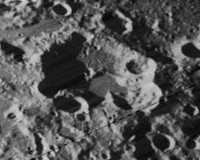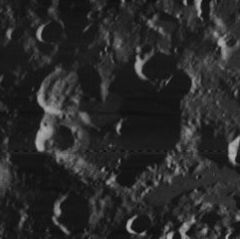Avicenna is a lunar impact crater that lies on the far side of the Moon, just beyond the western limb on the northern rim of the Lorentz basin. It is named after the Persian polymath Avicenna. It lies to the north-northwest of the larger crater Nernst, and to the southeast of Bragg.
 Clementine mosaic | |
| Coordinates | 39°42′N 97°12′W / 39.7°N 97.2°W |
|---|---|
| Diameter | 74 km |
| Depth | Unknown |
| Colongitude | 98° at sunrise |
| Eponym | Avicenna |


The northern half of Avicenna has been obliterated by subsequent, overlapping impacts. The southern and southeastern rim is worn and eroded, but the outline can still be discerned. There is a small crater lying across the southern rim, although this formation is equally worn. Several small craters lie across the southern extent of Avicenna's floor.
Satellite craters
editBy convention these features are identified on lunar maps by placing the letter on the side of the crater midpoint that is closest to Avicenna.
| Avicenna | Latitude | Longitude | Diameter |
|---|---|---|---|
| E | 40.0° N | 91.1° W | 25 km |
| G | 39.0° N | 92.0° W | 26 km |
| R | 38.9° N | 100.1° W | 21 km |
References
edit- Andersson, L. E.; Whitaker, E. A. (1982). NASA Catalogue of Lunar Nomenclature. NASA RP-1097.
- Blue, Jennifer (July 25, 2007). "Gazetteer of Planetary Nomenclature". USGS. Retrieved 2007-08-05.
- Bussey, B.; Spudis, P. (2004). The Clementine Atlas of the Moon. New York: Cambridge University Press. ISBN 978-0-521-81528-4.
- Cocks, Elijah E.; Cocks, Josiah C. (1995). Who's Who on the Moon: A Biographical Dictionary of Lunar Nomenclature. Tudor Publishers. ISBN 978-0-936389-27-1.
- McDowell, Jonathan (July 15, 2007). "Lunar Nomenclature". Jonathan's Space Report. Retrieved 2007-10-24.
- Menzel, D. H.; Minnaert, M.; Levin, B.; Dollfus, A.; Bell, B. (1971). "Report on Lunar Nomenclature by the Working Group of Commission 17 of the IAU". Space Science Reviews. 12 (2): 136–186. Bibcode:1971SSRv...12..136M. doi:10.1007/BF00171763. S2CID 122125855.
- Moore, Patrick (2001). On the Moon. Sterling Publishing Co. ISBN 978-0-304-35469-6.
- Price, Fred W. (1988). The Moon Observer's Handbook. Cambridge University Press. ISBN 978-0-521-33500-3.
- Rükl, Antonín (1990). Atlas of the Moon. Kalmbach Books. ISBN 978-0-913135-17-4.
- Webb, Rev. T. W. (1962). Celestial Objects for Common Telescopes (6th revised ed.). Dover. ISBN 978-0-486-20917-3.
- Whitaker, Ewen A. (1999). Mapping and Naming the Moon. Cambridge University Press. ISBN 978-0-521-62248-6.
- Wlasuk, Peter T. (2000). Observing the Moon. Springer. ISBN 978-1-85233-193-1.
External links
edit- Media related to Avicenna (crater) at Wikimedia Commons